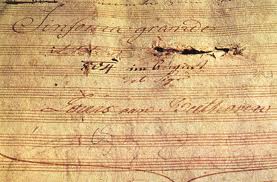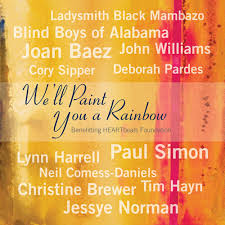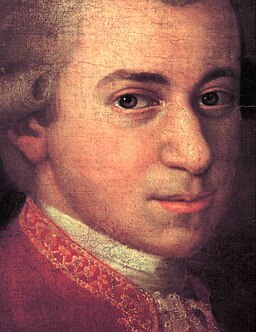
Revolutionary, exhilarating, ferocious, heroic…these are all words which could describe Beethoven’s Symphony No. 3 in E-flat major (“Eroica”) Op. 55. The “Eroica” stretches the elegant Classicism of Mozart and Haydn to its breaking point and plants the seeds of Romanticism. This is music of Revolution (the French and American) and the ideals of the common man.
The dawn of Romanticism brought profound changes. The stately private palace gave way to the public concert hall. Orchestras became bigger and louder. Symphonic structures expanded. The heroic struggles of man and the poetry of nature were elevated.
Beethoven originally dedicated this symphony, written in 1804, to Napoleon Bonaparte. When Napoleon declared himself Emperor, betraying the ideals of the French Revolution, Beethoven angrily crossed out the dedication on the title page and replaced it with a dedication to heroes (“Eroica”).
[typography font=”Cantarell” size=”28″ size_format=”px”]Allegro con brio[/typography]
Let’s start by listening to the first movement, performed by Leonard Bernstein and the Vienna Philharmonic. The piece begins with a surprise…two thunderous musical “hammer blows.” Pay attention to the underlying pulse as the music develops, growing like a living organism from these opening chords. Can you hear moments where a competing rhythmic groove fights against this established pulse? Do you hear anything which suggests conflict or struggle?
This movement is built on sonata form. You can learn more about this type of musical structure here. As the piece unfolds, pay attention to this overall structure as we move from the exposition (which gets repeated at 3:40) to the development (around 6:49) and back home to the recapitulation.
https://www.youtube.com/watch?v=W-uEjxxYtHo
[button link=”https://itunes.apple.com/us/album/beethoven-symphony-no.-3-in/id344778843″]Find on iTunes[/button] [button link=”http://www.amazon.com/Beethoven-Symphony-Eroica-Egmont-Overture/dp/B00000E2WK”]Find on Amazon[/button]
[typography font=”Cantarell” size=”28″ size_format=”px”]A Few Details…[/typography]
Can you imagine how shocking those opening “hammer blow”chords would have been for the first audiences in 1805? Beethoven makes the orchestra growl with a ferocious intensity which had never before been heard. When I play orchestral music by Beethoven, I always get the sense that the classical orchestra is being pushed to its limits. The musical vision almost seems too big and powerful to be contained. Beethoven’s compositional style also reflected the monumentality of the work. His sketches suggest that he struggled relentlessly over each motive. The most minute detail separated the pedestrian from the sublime.
Now that you have an idea of the piece, let’s go back and listen again. From the beginning, you probably felt the music flowing in groups of three (3/4 time). Quickly, however this clear pulse becomes infected with a competing groove, first with jarring accents on the “wrong” beat (around 1:00), then with more overt “hammer blows” (3:00-3:32). The music always makes us feel a little off balance. Go back and listen to the exposition again, paying attention to this rhythmic conflict.
Towards the end of the exposition, the music tells us that something new is about to happen (3:26-3:40). Beethoven heightens our anticipation, but listen to what happens…We abruptly return to the beginning of the exposition. Classical symphonies commonly repeated the exposition, but Beethoven goes out of his way to make this transition as sudden and jarring as possible. Listen to what happens the second time we come to this musical “fork in the road” (6:42-7:09). This time we move further away from “home” into completely new musical territory. This is the development, the mid section of sonata form where the motives (the DNA of the piece) go through all kinds of exciting and far reaching embellishments and transformations. Listen to the way the opening motive is obsessively repeated in different guises (and keys) throughout this section, simultaneously spinning off new, but related musical material. This is the most unstable part of the piece, where anything can happen. Can you hear the music getting increasingly wound up throughout this section as it searches for a distant and elusive goal?
Listen to the intense passage beginning around 8:44 one more time. This is the moment where the rhythmic conflict we heard in the exposition explodes with a new insistence and completely takes over. This passage ends with a shockingly dissonant chord at 9:26. This harsh new sound is something we might expect to hear in twentieth century music by Stravinsky. It’s the furthest you can get from the elegant, refined sound world of Mozart and Haydn.
Another innovative moment comes with the “false” horn entrance around 11:36. During the first performances, even Beethoven’s most devoted students assumed that this had to be a misprint in the score. It was just too weird. Listen to the way the horn emerges from the eerie tremolo in the strings. A few moments later, after a modulation, a new horn solo appears in the “right” key.
One of the most fundamental aspects of a symphony is the sense that the music is always going somewhere. It’s constantly developing, evolving and searching. From the opening chords on, one musical motive and phrase spins into the next in this unfolding process. Consider the musical “fork in the road” we heard at the end of the exposition. Listen to what happens when we come to this critical junction again in the recapitulation, after 15:04. For the first time the music suddenly seems lost…out of ideas…unsure which direction to take. The motion almost stops. Can you tell how the music finds its way again? Listen to the second violins for a clue.
In the climactic coda, listen to Beethoven’s use of the trumpets and horns and consider the heroic connotations of these instruments. Notice that the rhythmic conflict we’ve heard throughout the movement is there, right to the final notes (17:52).
[typography font=”Cantarell” size=”28″ size_format=”px”]Listen Again[/typography]
Now that we’ve focused on some of the details in the music, go back and listen again. Listen freely with an open mind. Have fun and enjoy the ride. You may hear completely new things in the music that you missed the first time. Share your own ideas in the thread below. What does this music mean to you? What emotional impact does it create? Be sure to come back Wednesday for Part 2, where we’ll explore the other three movements.

 The vibrant Fall colors outside my window are a great excuse to listen to Vivaldi’s third concerto, “Autumn” from “The Four Seasons. Antonio Vivaldi (1678-1741) was writing and playing this music at a time when the violin was developing as a virtuosic instrument. There’s a youthful joy in this music, as if he’s saying, “Look what the violin can do!” The key to playing this music well is to make the technical passages sound effortless and fun.
The vibrant Fall colors outside my window are a great excuse to listen to Vivaldi’s third concerto, “Autumn” from “The Four Seasons. Antonio Vivaldi (1678-1741) was writing and playing this music at a time when the violin was developing as a virtuosic instrument. There’s a youthful joy in this music, as if he’s saying, “Look what the violin can do!” The key to playing this music well is to make the technical passages sound effortless and fun.

 Last March, cellist Lynn Harrell and a host of fellow all star musicians, including John Williams and Jessye Norman, released a special recording called We’ll Paint You a Rainbow. The recording raises money for the
Last March, cellist Lynn Harrell and a host of fellow all star musicians, including John Williams and Jessye Norman, released a special recording called We’ll Paint You a Rainbow. The recording raises money for the 